The Bitcoin ecosystem contains huge potential
Bitcoin is the cornerstone of the entire encryption industry, with its current market value reaching $874.8B, but most of the time it is only used as a value storage carrier for "encrypted gold".
WBTC is a rare way for Bitcoin to flow into the DeFi field. It is an ERC20 asset mapped 1:1 by the centralized custodian BitGo. The current market value is $7B. Less than 1% of the market value of Bitcoin itself.
Therefore, the Bitcoin network actually has a large amount of asset liquidity that has not been released, and the native ecosystem of Bitcoin has huge challenges. underlying momentum.
Contrary to widespread belief, the Bitcoin network does not support smart contracts. Just for the sake of security and simplicity, although the supported smart contract programming language Script is not Turing complete and not as powerful as Solidity commonly used on EVM, it can still support multi-signature, time lock, and partial signature transaction (PSBT). and other functions.
SegWit (Segregated Witness) upgrade allows witness data (unlocking the signature information of UTXO transactions) to have an independent isolation space, and the capacity reaches 4MB, expanding the chain The type of media stored.
The upgrade of Taproot enhances the privacy of transactions, while allowing Bitcoin to perform more complex transactions and store data in the Taproot script path. In the spending script, these have promoted the birth of the subsequent Ordinals protocol, spawned the distribution of new assets, brought about the prosperity of new Bitcoin assets such as BRC20, and brought people's attention back to the possibilities of the Bitcoin ecosystem.
The ecology on the chain feeds back the Bitcoin network
Many Bitcoin OGs insist that Bitcoin should remain simple and pure and play a good role as a value reserve. But the lack of on-chain activity can actually be harmful to Bitcoin.
Take the upcoming Bitcoin halving as an example. The current reward of 6.25 BTC per block will be reduced by half, which means that the income of miners will be greatly reduced. Shrinking, if it cannot make ends meet, will naturally lead to a reduction in the number of miners, a reduction in decentralization, and a corresponding increase in vulnerability to attacks.
There are only two solutions to avoid this situation, the price of Bitcoin will rise (even if the price of Bitcoin doubles, the block reward income will remain balanced with the present) ; Or active BTC chain activities lead to more handling fees - and this has been verified by the Ordinals protocol and BRC20.
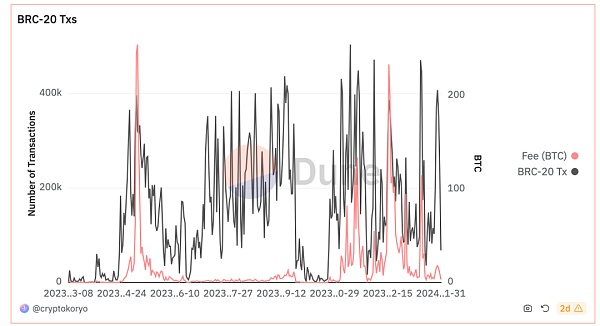
(Source: https://dune.com/cryptokoryo/brc20)
The two waves of BRC20 in May and December both led to a significant increase in the income of BTC miners. So far, the Ordinals protocol has brought 5979.4 BTC (~$257.7M) to BTC miners. The income far exceeds the coinbase income of miners.
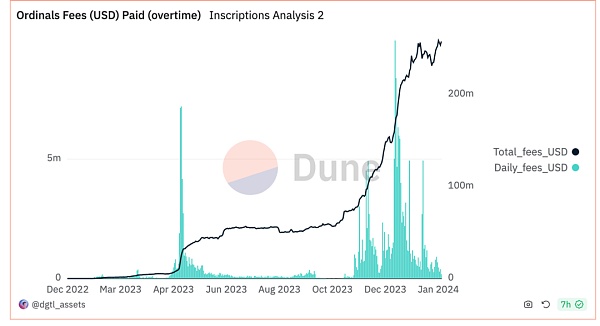
(Source: https://dune.com/dgtl_assets/bitcoin-ordinals-analysis)
A method often used by Bitcoin developers to measure network security is to evaluate the number of full nodes. In order to allow personal PCs to run full nodes, the block size and UTXO set must be strictly limited to reduce the cost of full nodes.
Judging from the number of BTC full nodes, due to the emergence of inscriptions, many people need to interact with Bitcoin RPC, which increases the number of Bitcoin full nodes.
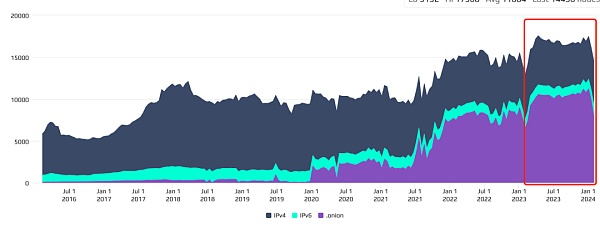
(Source: https://bitnodes.io/dashboard/8y/)
Obviously, the BTC network needs ecological empowerment. Rich on-chain activities not only bring economic benefits to miners and make up for the losses after the halving, but also increase the number of full nodes and increase the network Security, and more importantly, allows more people to truly understand and use BTC.
B² Network’s mechanism to unleash the potential of BTC
The reason for the lack of application of BTC is not only the limitations of the smart contract language, but also the fact that it is slow and expensive.
On Ethereum, an important means of Layer 2 expansion is essentially to use the idea of a modular blockchain to separate the execution layer to improve efficiency, while at the same time enabling Inherit the security of the Ethereum network.
The past year has also been a great year for Ethereum Layer 2. More than 20 Ethereum Layer 2 public chains have been launched, and the concept of Layer 2 is deeply rooted in the hearts of the people.
If you want to unleash the potential of Bitcoin, a natural idea is to build a second-layer network to achieve expansion, use efficient and fast virtual machines, or everyone can The familiar EVM serves as the execution layer to make up for some of the shortcomings of BTC itself.
B² Network is a pioneer of the BTC second-layer network. It is based on Bitcoin's zero-knowledge proof verification commitment, and the EVM-compatible ZK Rollup, Ethereum bring his talents to the Bitcoin ecosystem.
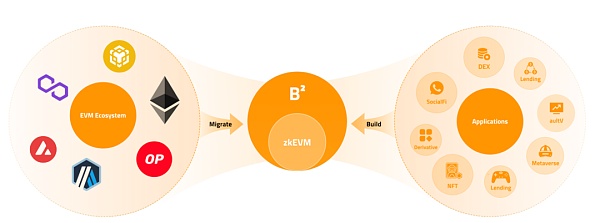
(Source: B² Network LitePaper)
Technical Architecture
B² Network’s technical architecture mainly includes two layers of structure, Rollup layer and DA layer. Simply understand this architecture: you need a virtual machine to process user transactions, and you also need a place to store data and verify transactions.
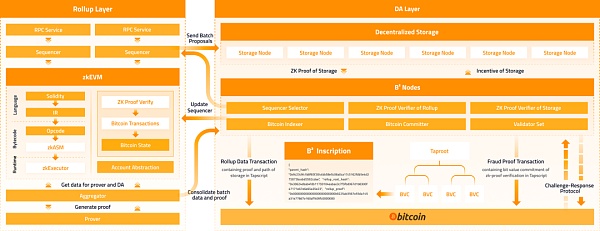
(Source: B² Network LitePaper)
In the Rollup layer, B² adopts the zkEVM solution and will work with Polygon Labs to expand Polygon CDK to BTC.
Through account abstraction, users can use either Ethereum accounts or BTC accounts to interact, while taking care of users with ecological habits on both sides. Commonly used Unisat, Metamask Other wallets can continue to be used to reduce user learning costs;
The main account can use the Transaction Bundler service to realize gas payment for sub-accounts.
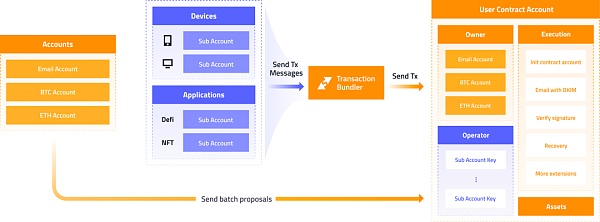
(Source: B² Network LitePaper)
Users' transactions are submitted and processed in the Rollup layer, and the user's status is also stored in the Rollup layer. The network will generate relevant zero-knowledge proofs, package them and send them to the DA layer for storage and verification.
The DA layer includes decentralized storage, B² nodes and the Bitcoin network, which is used to verify Rollup’s zero-knowledge proof and permanently store a copy of the Rollup layer’s data. And finally the data is engraved into the Bitcoin network through inscriptions.
The entire data process is shown in the figure below. After B²’s sorter packages the user transaction data, it saves it through distributed storage to avoid single points of failure and increase reliability.
In order to ensure data availability, B² will write Tapscript scripts to the Bitcoin network in each block to achieve continuity in data availability time.
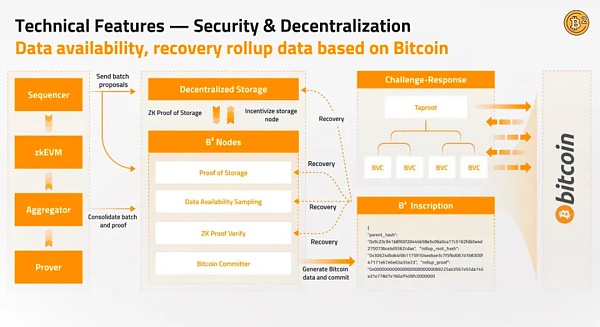
(Source: B² Network LitePaper)
In the Ethereum network, Rollup transfers data from the second-layer network to the contract on the main network through calldata to verify transactions and save data. However, the Bitcoin network does not support automatic verification of smart contracts. ZK-Rollup only passes Taproot writes zero-knowledge proof and Rollup's aggregated data into Bitcoin, ensuring that ZK-Rollup's data is anchored in Bitcoin and cannot be tampered with.
But it does not guarantee the validity and correctness of transactions within ZK-Rollup, nor can it use Bitcoin's powerful consensus capabilities to ensure Layer 2 ZK-Rollup safety.
Therefore, the solution adopted by B² is to write the commitment of zero-knowledge proof into the main network, allowing challengers to verify the commitment of zero-knowledge proof within a specified period. issue a challenge.
If someone challenges successfully, Rollup will be rolled back, and the challenger will win the node-locked assets; and if no one challenges during the challenge period or the challenge fails, Rollup will Will get final confirmation on BTC.

(Source: B² Network LitePaper)
B² design has several very clever points:
1. First, it uses account abstraction to lower the user’s learning threshold, which actually reduces assets. The threshold for access makes it convenient for users to access the wallet wherever they have assets;
2. The second-layer network is EVM compatible, making it easy to introduce developers and Ethereum Ecological migration of the workshop;
3. The overall adoption is a hybrid model similar to zk+op, using zk for data verification, reducing transaction costs, and using op challenges at the same time mode to avoid the problem of limited BTC verification capabilities.
B² Network’s vision is not limited to a BTC Layer 2, but has the same ambition as Cosmos Hub or Op Stack to become a BTC Layer 2 center.
In the future, B² Nodes will be upgraded to B² Hub. B² Hub will provide services based on The data availability layer and state transformation verification and proof system of the Bitcoin network.
In the future, developers can choose the Polygon CDK + B² Hub combination to build their own BTC Rollup.
B² Token Economy
In the design of B² Network, there are many links that require decentralization, and there are token incentives:
- < p style="text-align: left;">Sequencer pledge
B² network implements decentralization through B² nodes Centralized sorter service, the sorter participates in the sequence validator election by staking tokens. This service updates the sorter set through a mechanism similar to DPoS. The sorter in the sorter set provides transaction sorting and packaging services in order.
When Rollup settles BTC via B² Hub, it needs to pay B² tokens to B² Hub. This part is used as Hub income and part will be burned.
Bitcoin miners can use their computing power on zero-knowledge proofs to gain new income after the Bitcoin halving.
The DA layer needs distributed storage nodes to store Rollup data copies and zero-knowledge proofs. Running storage nodes will also receive token incentives.
Token holders can vote on protocol proposals.
Users who pledge tokens can share part of the platform’s gas fees.
How to participate
1. B² Buzz

(Source: https://buzz. bsquared.network/)
B² Buzz is a user incentive activity launched by B² Network. Users can go online on the mainnet in early February. Recharge assets within the first three days to obtain parts for assembling the mining machine, which can mine B² native tokens. During the event, all funds are securely managed via a multi-signature method, and bridge assets can be withdrawn to the Tier 1 network where they were deposited in April 2024.
Assets that can be deposited include:
-
BTC: BTC on the Bitcoin network, wBTC on Ethereum, BTCB on the BNB chain
BRC20 assets: ORDI, SATS
ETH: ETH on Ethereum
Stablecoins: USDC and USDT on Ethereum; FDUSD on the BNB chain
Matic: MATIC on Polygon
You can get more deposit rewards and unlock by forming a group For higher level treasure chests, use Biteye’s invitation link, https://buzz.bsquared.network/?code=kUClH, and you can also get additional benefits:
< li>50% invitation points share
MiniBridge monthly card with 20% off
Deposit more than 500U and get a CryptoHunt monthly card (currently worth 0.1e)
< p style="text-align: left;">2. B² Network Odyssey
Users can follow and participate in Odyssey activities on the B² website before the mainnet goes online The deposited assets will be bridged to the B² main network and circulated within the ecosystem. Users can use these bridged assets to interact with ecosystem dapps, follow tasks to gain more points, and may receive potential airdrops in the future.
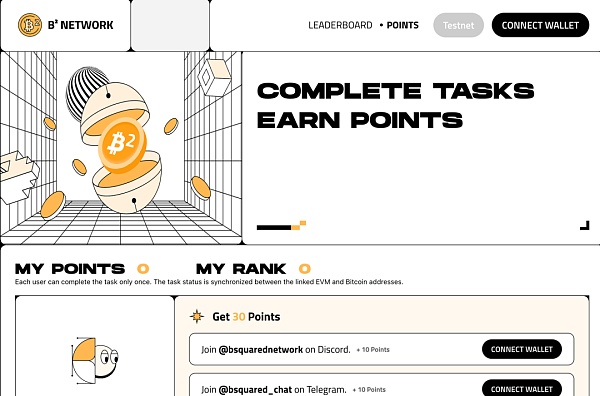
(Source: https://buzz.bsquared.network/)
3. Development
B² released a $1 million Grant project to encourage developers to This new BTC L2 is being developed. Currently, six projects have received grant sponsorship in the first round, including:
A native DEX on B² serving BTC-related assets.
The protocol based on Ordinals aims to help more DApps and game applications establish their own asset systems in the BTC ecosystem.
L2scan is a block browser focusing on L2 Rollup.
NFT project, you can plant, breed, trade and chat with other cat lovers in the PawX virtual universe.
An artificial intelligence-driven NFT astrology application.
A full-chain game using zk algorithm.
Summary
B² Network has greatly expanded the scalability of the BTC ecosystem by introducing EVM-compatible BTC Layer2.
Use zk rollup to significantly reduce transaction fees, and through clever architectural design, combined with methods similar to fraud proofs, zk commitment proof accepts user challenges, in order to It solves the limitation that the BTC layer cannot be contract verified.
B²’s partners are all leading projects, such as using the Particle Network solution for account abstraction, cooperating with Raas’ AltLayer, and now working with Polygon Labs to build the first A BTC use case for Polygon CDK.
Strong partners can also help B² become one of the most viable Bitcoin L2 solutions, worthy of attention and early participation.
 JinseFinance
JinseFinance













